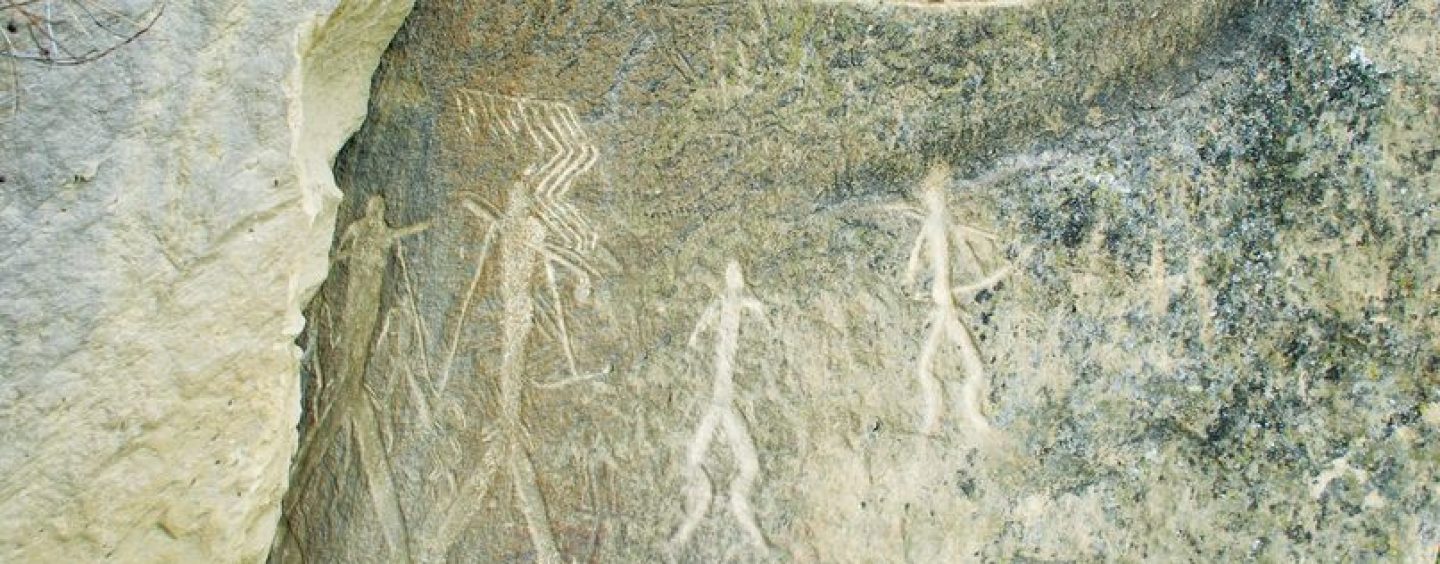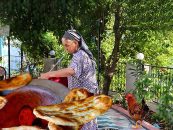By Togrul Mashalla
The history of Azerbaijan dates back to ancient times. Each year we learn more and more about the country’s antiquity, lifestyle and traditions of our ancestors thanks to the work of Azerbaijani archaeologists. One of the monuments of antiquity, which shed light onto the life of ancestors, is the rock art of Gobustan. By using the term “drawing,” we emphasize that many rock drawings go beyond conventional pictographs (i.e. writing in pictures). Among other things, this writing used leather scraps, wooden planks and other nondurable materials. Only stone preserved some of this ancient art for us.
Gobustan is a desert area indented with ravines and strewn with mud volcanoes, located 60 kilometers west of Baku. Until the middle of the last century, this land was used by the sheepherders for grazing, and by geologists who kept fruitlessly searching for oil. Men were rarely seen in this area. Even the locals tried to avoid this area, paving roads around Gobustan. However, it is here that in the spring of 1939 archaeologist Isaac Jafarzadeh made a great discovery –he revealed a unique archeological monument, an open-air art museum consisting of several exhibitions and galleries of petroglyph collections. It turned out that the mountains of Boyukdash, Kichikdash, Jingirdag, Shongardag and Shyhgaya in Gobustan massed abundant historical evidence of Azerbaijan. The drawings depicted people, animals, boats and various symbols. Currently, their total number exceeds 6000. The drawings vary: images referring to different centuries, sometimes even millennia, are located adjacent to each other and some drawings even overlap. Despite their large numbers, we have known and studied them for a little over 70 years. Their study dates back to 1939, and was preceded by a rather interesting story about the discovery of the petroglyphs.
It is said that these places were known to various Russian and English scientists and petroleum engineers as early as in the 19-20th centuries. It is of no wonder that the entrance to the main cave even has an inscription of certain Cruise, who visited here in 1905. In 1924, one Russian engineer and part-time hunter decided to hunt in Gobustan. In those days, Gobustan harbored gazelles, wild goats, foxes, wolves, jackals, hares and many other species of animals and birds. During the hunt he discovered petroglyphs on the rocks. But another and final discovery of these places had occurred in the 1930s. At the time there was a stone quarry in that area, and the ground was covered with large boulders. During the works one of the employees spotted unusual paintings on the rock. The more the area was cleared, the more images became visible. Most of the drawings were discovered in caves. The work in the quarry was immediately stopped and scientists were notified about the discovery. Thus began the scientific study of Gobustan and Azerbaijani archeologists have been working here now for over 70 years. Owing to their work, we can now observe the formation of our ancestors’ spiritual world, how the scope of their interests changed, beginning with the Mesolithic era of some of the earliest drawings, and to the Middle Ages. To date this area, along with the drawings, has been found to contain ancient dwelling-caves and sites, around 40 mounds and over 105000 artefacts.
The history of Gobustan began in ancient times. As evidenced by the presence of various types of gray soils, the desert or semi-desert vegetation really dominated in Gobustan about 20 to 17 thousand years ago. Weather temperature at the time was below that of today by 5-10 degrees and atmospheric precipitation was lower by 200 mm per year. The level of the Caspian Sea at the time was over 20 meters below that of the present. The rivers of the region were shallow and flooded only small areas during the high water, leaving the predominant type of unproductive desert vegetation virtually unchanged. However, 16-15 thousand years ago, things started to change. A warming process began around the globe. During this period, glaciers started melting, at first the process was gradual and then increasingly more rapid. At the same time, the amount of precipitation had increased as well. Rivers dramatically increased their water content and during the overflows began flooding large areas, fertilizing their valleys with silt, and thus laying the foundations for future river-civilizations.
The first effect was ensured by the rapid rise of the Caspian Sea level. The latter surpassed even the current level and had, about 13-11 thousand years ago, climbed to more than 10 meters above the present level. And for about 10 thousand years, it completely rose to reach the oceanic level, which is normally about 25-30 m higher than the current sea level. A paleoclimatic reconstructionevidences that,in the past 15 thousand years, the temperature,in the Caspian region of Azerbaijan, had occasionally reached its maximum levels and was, at times, higher than today by 2-3 degrees. The rainfall reached current rates.
In Azerbaijan, warming had created conditions for the development of tree vegetation. Arid savannah woodlandsdeveloped here as vast inundations and floods formed lowland meadows creating widespread riparian forestsalong rivers. The landscape of Gobustan was a kind of savannah with an abundance of food resources. It was populated by large herds of wild bulls, Persian wild goats, deers, wild horses, koulans, gazelles, scores of lions, wolves, pigs and other animals. Therebeside, the riparian forests gradually increased the number of their wild animal populations.
Thus, Gobustan emerged as a land that had living conditions for a variety of animal speciesas well asancient people. Thatera coincided with the beginning of the Mesolithic age characterized by the appearance of microlites, bows with arrows and fishing gear. All this was in possession of Gobustan’s first inhabitants who came here about 15-14 thousand years ago i.e. in the XIII-XII millenniaBC. According to recent studies, this time is associated with the beginning of the Mesolithic era. One of the first Mesolithic cultures, the Zarzi culture,emerged in northeastern Iraq, dating backto the XIII-XII millennium BCE.
The distinctive feature of this complex of cultural monuments is the presence of asymmetrically shaped geometric microlites with a notch on the side used for arrowheads. Through fishing and mastering river navigation, representatives of this culture reached Black Sea in the west and Caspian Sea in the East. Microlites with Zarzi features were found at the site of Gayaarasy, the most ancient settlement of Gobustan founded upon Kichikdash Mount. The remains of fish and seals found here indicate that denizens of this ancient settlement were actively engaged in fishing. Back then, sea waterline came very close to the site area, and the same is true even today. The dwellers also sailed in boats depicted on the rock monuments in Gobustan. Judging by the drawings, the boats were of small size designed for 2-6 people and were woven of reeds and sedge. One of the drawings shows a flotilla where the number of boats reached 27. It is extremely interesting to note that a large number of boats had an image of sun at their bow, whichimageresembles pictures found in Karelia, Sweden and Africa (mainly in Egypt). Most likely, the boats shown in these carvings are the same vessels which Zarzi dwellers used to navigate rivers, lakes and seas while still in Mesopotamia. Hence, they resemble those used in navigation much later in Mesopotamia and elsewhere, as well as the one used by Thor Heyerdahl (“Ra”) in the twentieth century. A well-developed fishing industry in Gobustan is also evidenced by a large number of discovered fishing gear (harpoons, net-making tools, sinkers, etc.). Numerous bones of gazelles, koulans and goats found at the Gayaarasy site indicate that the ancient Gobustan dwellers had also engaged in hunting. Multiple rock carvings also evidence the fact that Gobustan residents were even able to hunt bulls. Moreover,the absence of bull-bones testifies to the fact that hunters only brought pieces of meat to the site since slaughtered animals were too heavy to transport.
But Gobustan was found to possess both rock carvings of animals and people and inscriptions lifting the veil of secrecy over the history of Azerbaijan. Thus, an archaeological petroglyph research expedition was going to end by summer 1948. Due to intense heat, archaeologists worked throughout spring and completed their work by early June. In the morning hours of June 2, at oblique incidence of sunlight, I.M.Jafarzadeh saw a Latin inscription on a large rock surface found at the southeastbottom part Boyukdashmountain. It read: “In the reign of Emperor Domitian, the invincible Caesar Augustus Germanicus, and Julius Maxim. The twelfth ‘Fulminant’Legion.” But the inscription’s significance comes from the fact that it tells us about a completely unknown military campaign implemented by ancient Romans in the first century AD (between 84 and 96 AD).
Also, the Jingirdag Mountain in Gobustan was found to contain a Persian cave inscription related to the 14th century, which reads: “Imad Shahkee came, prayed and left.” Based on this inscription, scholars believe that this place served as a sanctuary. In this engraving, a ‘mohur’ (circle, symbolizing Muslim prayer tiles) used in namaz is shown after the word “pray.” Popularly named “Jingir Baba” and worshipped, Jingirdag mountain retained its religious significance until the end of the 19th century.
It should be noted that,besidesJingirdagMountain, the Yazyly Mountalso possessed magical and religious significance. Pictures of sacrifice carved in stone serve as a documentary evidence to this fact. It shows people in prayer with hands raised. Many a stone show carved celestial bodies and a variety of religious and spiritual signs. Also of interest is a group ritual and ceremonial dance that resembles our contemporary dance called “Yally.”
The mountain called Gavaldash, an original stone-drum, is a flat piece of limestonethatis another important attribute of Gobustan. Resting on two foot-stones,it creates an illusion of being suspended in mid-air. It rests on a huge rock slab. By tapping a small stone on it one can produce distinct rhythmic tunes. Sounds made by Gavaldash depend on the density of limestone shells. Gobustan has 2 gavaldashtypes of drum stones: one is situated at the northern foot of Jingirdag mountain,while the other one is found in Boyukdash mountain. It is believed that gavaldash was used by the hunters and herders who lived in this area.
This legacyinvited worldwide attention, including many scientists and researchers. Upon having visited Gobustan, Thor Heyerdahl, the world-renowned Norwegian explorer and traveler, said that what he saw here surpassed all his expectations. He stressed that – while havingtraveled the world, visited many countries and long been engaged in seafaring history -“for the first time in Gobustan,I saw the sun on the bow of ships and not on their sails. What ancient and, undoubtedly, advanced civilization abode here, yet remains a mystery.” According to him, the boats of Gobustan with curved bottom are absolutely unique. Upon comparing Norwegian petroglyphs with the ones found in Gobustan, he inferred that they were carved “by the same hand, but at different time.” All the while, in his opinion, the rock carvings of the Gobustan boats were similar to Viking ships. No wonder, Heyerdahl and members of his delegation noted that the best way of transporting equipment from Norway to Azerbaijan was via the ancient Viking trade route, which started from the Baltic Sea and ran through Russia by the Volga river. T.Heyerdahl wondered: “What if their ancestral home is located in the Caspian Sea? Perhaps, this is where the endless journey of the blond travelers began, whose remains are found in the frozen tundra and inland China, on the African coast under the name of Berbers, and which reached as far as the Canary Islands?” All this yields new grounds for further thorough study of Gobustan.
In view of the historical and artistic value, and universal importance of Gobustan monuments, an area of 4400 hectares was, 9 September 1966,attributed the status of a national Reserve. Today’s Gobustan is known as an open-air museum visited by thousands of people from around the world. The world value of Gobustan Reserve is unimaginable and, considering this, the Government of Azerbaijan has in 2002 presented UNESCO with all necessary documents for appropriate inclusion of this Reserve into the list of World Heritage Sites. For this purpose, a management plan along with Gobustan’s nomination were duly prepared and submitted to UNESCO in 2006. Experts from UNESCO and ICOMOS supported the plan of Azerbaijan. At the 31st session of the UNESCO World Heritage Committee – took place between 23 June and 2 July 2007 in Christchurch, New Zealand – the cultural landscape of Gobustan rock carvings was included in the World Heritage List.
Though the whole world considers Gobustan as one of the greatest sites of pristine artmonuments, revealing the life and culture of our ancestors, to Azerbaijan, these rocks mean are a lot more, namely, the incarnatedmemory and historyof our ancestors.






